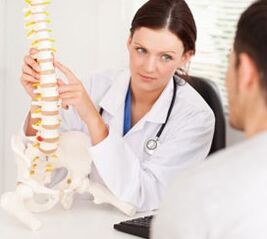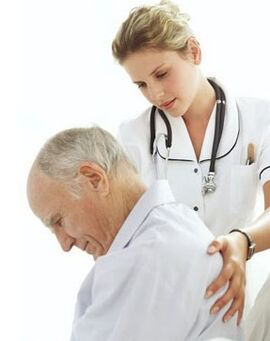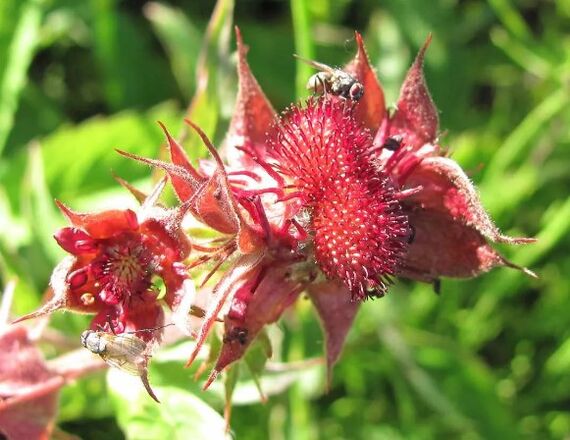Osteochondrosis-The disease of the spine, which is characterized by intervertebral discs, and then the degenerative-dynist lesion of the spinal tissue themselves.
The main sign of osteochondrosis is pain in the neck or back. Other symptoms include muscle atrophy, impaired sensitivity, and disorders in the work of internal organs. Depending on the localization of the pathological process, the cervix, chest and lumbar osteochondrosis can be distinguished. If this disease and treatment do not pay the necessary attention, the spine damage will be irreversible.
In English literature, the term "osteochondrosis" represents a group of such diseases of the muscle system, such as osteochondropathy.
The main factor, or the cause that leads to the development of osteochondrosis, is an uneven distribution of spinal load, which occurs when we wear in one hand or in the shoulders of weights (such as bags, backpacks), a long stay in the wrong position, night rest on an uneven mattress or pillow. Other factors may include sedentary lifestyles, obesity, injuries and flat legs.
The above situations over the years lead to frequent pain in the cervix, chest or sipral spine.
According to statistics, osteochondrosis occurs in 40-90% of the world's population, especially from the age of 30-35. Under harmful conditions, this disease develops in adolescence people, which most often contribute to wearing a severe, unpleasant backpack, especially on one shoulder, uncomfortable shoes and injuries.
The formation of osteochondrosis
The formation of osteochondrosis occurs in 4 selected stages (degrees):
Section 1 osteochondrosis.This is characterized by the onset of the abnormal process of the intervertebral disk's polyposis core - dehydration (dehydration) and later the height of the plate decreases. At the same time, the cracks appear in the fibrous ring. At this stage, the patient usually does not feel changes. The inconvenience can be manifested in an unusual situation for a person or active exercise.
Osteochondrosis 2 stages.With the decrease in the height of the discs, the distance between the adjacent vertebrae also decreases and the vertebrates and tapes are slightly descended. This process leads to ultravravity of two adjacent vertebrae, which can lead to slip and/or displacement. Spondylolistz develops. Due to the displaced vertebrae, the patient feels real discomfort and sometimes pain in the pathology at a certain load.
Osteochondrosis 3 stages.This is characterized by the formation and protrusions of the plates of the discs, sometimes subluxation and artrosis in the intervertebral joints. The patient may feel stiff in certain movements, feel tingling in the limbs, and sometimes numbness appears. In the third degree of osteochondrosis, the pain in the back, neck and coccyx, depending on the localization of the disease, is already present.
Osteochondrosis 4 stages.The body tries to repair the excessive mobility of the vertebrae and normalize the spine. At the site of the vertebrae and pathology, there is an increase in bone pieces - osteophytes, which, in excess, can lead to the microtrauma to the nerve spine and sometimes to adjacent vertebrae. In discs and joints, the process of fibrous ankylosis can begin. The engine segment is overgrown and becomes as if it were on the wall. At the same time, the main signs of osteochondrosis are minimized, and sometimes they are usually virtually not noticeable.
Symptoms of osteochondrosis
The main symptoms of osteochondrosis are discomfort and pain in the back or neck. Other related signs of pain and this disease depend on the degree of osteochondrosis.
Of course, due to the growth of the pathology, hernia, the growth of the vertebrae (osteophytes), many disorders, such as circulatory disorders, nerve grips, irritation and violations lead to the normal functioning of the spinal cord. All of these disorders can cause an extensive clinical picture of the disease and express abundant amounts of different symptoms, so it is very difficult to make the right diagnosis and proper treatment without thorough diagnosis of osteochondrosis.
However, the main symptoms of osteochondrosis are taken into account:
- Pain in the back, the cervical region, the lower back, the shoulders and even the ribs;
- inconvenience, the stiffness of the back with certain movements, lifting something;
- numbness of the limbs (arms and/or legs);
- Feeling of pain in the arms and legs, chills;
- muscle spasms;
- disorders in the work of the genitals;
- headache, dizziness;
- heartache;
- impaired sensitivity;
- muscle hypotension;
- Increased fatigue, sometimes the eyes.
In addition, depending on the spine, in which osteochondrosis stretched, the following symptoms differ:
The cervical spine is osteochondrosis.Pains of hands and shoulders, headaches, dizziness, "flies" or stains in the eyes, noise in the head. These signs may also indicate the presence of spinal arterial syndrome, which can also complicate the work of the heart muscle and myocardial vascular system if other diseases are in it.
Chest spine osteochondrosis.Chest pain, heart areas and discomfort in breathing.
The lumbosacral spine is osteochondrosis.The pain of the lower back dominates the legs or the pelvis organs. Violation of sexual function.

Complications of osteochondrosis
If osteochondrosis is not treated and put in a groove, this can lead to the following diseases and pathologies:
- Damage to the intervertebral disk (spine hernia);
- protrusion;
- kyphosis;
- radiculitis;
- insert in the space between the salts;
- spinal cord -stroke;
- weight loss of the limbs and their atrophy;
- The paralysis of the legs.
Causes of osteochondrosis
- The back mechanical trauma (spine);
- physical surge of the body, hard work;
- nervous exhaustion, stress;
- Violation of metabolism, intoxication;
- Frequent stay in places with increased vibration;
- hereditary predisposition;
- sitting lifestyle, sitting work;
- Posture violation early;
- overweight, obesity;
- flat foot;
- Wearing uncomfortable shoes (crowded, heel);
- Night vacation on an uncomfortable bed - mattress, pillow;
- frequent dehydration;
- lower levels of nutrition, hypovitaminosis;
- smoking;
- pregnancy.
Classification of osteochondrosis
The classification of osteochondrosis is very diverse as the disease itself has not been fully examined.
We highlight the most popular ways to separate the disease.
Osteochondrosis is distinguished. . .
By localization:
- The cervix class ©
- Chest region (th or d)
- Lumbar (l)
- The sacral class (s)
Diagnosis of osteochondrosis
Diagnosis of osteochondrosis includes the following test methods:
- anamnesis;
- X -Ray examination (X -Ray);
- myelography;
- Neurological examination.
In addition, they may be appointed:
- Computer tomography (CT);
- nuclear magnetic resonance (JAMR);
- Magnetic resonance tomography (MRI).
Treatment of osteochondrosis
Treatment of osteochondrosis involves the use of a set of measures that should be done for a long time (1-3 months + about 1 year to rehabilitation), to which many patients respond very ambiguously. Therefore, it should be noted that indirectly, the participating doctor's recommendations are minimal for the restoration of the patient.

Another problem with treating osteochondrosis often becomes self -mediation. The thing is, as you have already written in the article, with this disease, the clinical picture is quite ambiguous and wide. A patient without diagnostics begins to choose medicines despite the pain eliminates pain and then deals with everyday life while the disease goes on.
Osteochondrosis is treated with two main methods: conservative and surgical treatment. In addition, there are general recommendations for the treatment of osteochondrosis, such as diet, rehabilitation.
Conservative treatment of osteochondrosis
The conservative treatment of osteochondrosis aims to normalize pain syndrome, spine and its components, and prevent further dystrophic changes in human axis.
Conservative treatment of osteochondrosis includes:
Drug treatment.It is used to relieve and alleviate metabolism components and metabolic processes.
Various therapeutic blockade is also used to stop pain and inflammatory processes. They also contribute to the reduction of muscle-tonic syndrome. There are therapeutic blockade: the blockade of trigger points and the intra-bone, paravebral and epidural blockade.
Physiotherapy.To relieve pain, improve the effectiveness of medication and during the rehabilitation period. Treatment is ultrasound, laser, magnetic fields, low -frequency currents, etc. Use.
Medical physical education (exercise therapy), kinin -natherapy.Especially selected, dosage exercises designed to repair, strengthen the muscle linen, correction of posture, normalize muscle tissue and elasticity, decompression of nerve roots, preventing the possible complications of the disease. Each of the above is due to the normalization and nutrition of the metabolism of the vertebrae, the restoration of blood circulation, discs and vertebrae due to the restoration of the load to the entire muscle system.
Massage.It is used to improve blood circulation, relieve muscle tissue stiffness and tension, and improve overall health.
Hydromasage.It contributes to the normalization of blood circulation, metabolism, the increase in muscle tone and the normalization of the nervous system. This includes body massage with a water flow that is targeted by a certain pressure. It is true that hydromassage has recently reigned with air bubbles transported to the body, specially equipped baths or pools.
Hand therapy.It is used according to a individually selected program that accurately affects the musculoskeletal system of the bone. It helps to improve blood circulation and lymph cycle, metabolism, muscle bone mobility, strengthening the immune system and preventing potential complications.
Extending (adhesion) of the spine.It is used with special equipment to increase the intervertebral space, the correction of the spine, which usually leads to minimizing or completely relieving pain.
Integrated use of the above treatment has a good effect on osteochondrosis.
Diet for osteochondrosis
In the case of osteochondrosis, it should be eaten 6 times a day in small portions and drinks at least 1, 5 liters of water daily.
What can you eat with osteochondrosis:Dairy products, low greasy meat types (chicken, beef), jelly, flooded fish, jelly meat, fresh vegetables (tomatoes, cucumbers, onions, carrots, beets, pepper, cabbage, celery, broccoli), fruits, avocado, nuts,
What should be minimized for osteochondrosis:Grapes, legumes (peas, beans, etc. ), flour products, spicy spices, sugar, salted foods, broth and smoked meats.
It is better to cook because of this method of making the products retain the amount of maximum vitamins and trace elements.

Try seasoning salads with olive oil.
Surgical treatment of osteochondrosis
Surgery treatment for osteochondrosis is used when the conservative method is ineffective. Prescribed by your doctor. It can also be used for serious injuries to the spine and its components.
Treatment of osteochondrosis with folk drugs
Folk medicines against osteochondrosis
Dough.Make a small dough from rye flour, 300 grams and let it lie at room temperature for a few days. Drink a glass of milk and rub the place where the back hurts with a turpentine. After wrapping the dough in a gauze and securing it to the sore spot, tie the cellophane to the top, then a scarf or towel. After a while you can burn and feel tingling in this area, but you can tolerate how much you know. Complete the procedure every other day. Use each dough three times.
Saber.Make a tincture of the swordfish. The place where the back pain hurts, with the made tincture with the made tincture and connects it with a handkerchief. In addition, a few drops can take a tincture from Saberfish before going to bed.
Ointment from osteochondrosis.Add 1 tablespoon to the container. A spoonful of flour, 1 egg, 100 g butter and 1 tablespoon. A spoonful of vinegar, mix everything thoroughly and put it in a dark place for 2 days to stick. After deleting the resulting foam from the mixture. Mix the mixture thoroughly and rub the resulting ointments into a sore spot.
Radish.Mix 300 ml radish juice, 200 g of honey and 100 ml vodka. Rub the back with the resulting mixture. This folk medicine also helps with radiculitis and rheumatism.



































